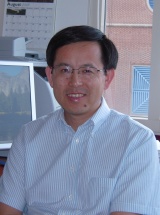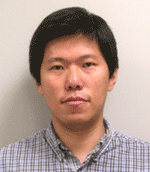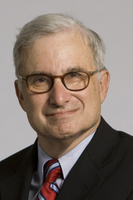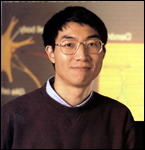
Venue: Room 101 (Deng Youcai Lecture Hall), Life Sciences Building
Date: May 20, 2013 (Monday)
Time: 13:00-14:00
Organizer: School of Life Sciences, Peking University
Song Wenchao, Ph.D., is professor from the Institute for Translational Medicine and Therapeutics and the Department of Pharmacology, Perelman School of Medicine, the University of Pennsylvania, Philadelphia, USA.
The complement system is a form of innate immunity that plays a key role in host defense. However, if not properly regulated, complement has the potential to cause significant host tissue injury, leading to autoimmune and inflammatory diseases in humans. In this talk, Professor Song will review the recent progress in research, including our own using various gene-targeted mouse models that has shed new light on the pathogenesis of complement-mediated human diseases. He will also discuss emerging therapeutic opportunities where new and mechanism-based treatments are being developed and tested in pre-clinical studies for these disorders.
>> The Trends and Development of E-learning in Higher Education

Venue: Room 403, Dianjiao Building
Date: May 20, 2013 (Monday)
Time: 14:00-16:00
Organizer: Center for Educational Technology, Peking University
Ting-Chuen Pong, professor of Computer Science and Engineering, Hong Kong University of Science and Technology, received his PhD in Computer Science from Virginia Polytechnic Institute and State University, USA in 1984.
Professor Pong's research interests include IT in Education, computer vision, image processing and multimedia computer. In 2013, he received the Best Oral Presentation Award at the 5th International Conference on Computer Engineering and Technology held in Vancouver, Canada.
>> Resolvable group divisible designs and (k,r)-colorings of complete graphs
Speaker: Shen Hao
Venue: Room 1493, Natural Science Building No.1
Date: May 21, 2013 (Tuesday)
Time: 15:00-16:00
Organizer: School of Mathematical Sciences, Peking University
A (k,r)-coloring of a complete graph K is a coloring of the edges of K such that all monochromatic connected subgraphs have at most k vertices. The Ramsey number f(k,r) is defined to be the smallest u such that the complete graph with u vertices does not admit a (k,r)-coloring. In this talk, Professor Shen would like to introduce his recent progresses on the application of resolvable group divisible designs in the study of (k,r)-coloring problem for complete graphs.
>> Innovation and entrepreneurship
Speaker: Lei Jun
Venue: Sunshine Hall, Yingjie Overseas Exchange Center
Date: May 22, 2013 (Wednesday)
Time: 16:00-18:00
Organizer: College of Engineering, Peking University
Lei Jun is chairman of Kingsoft Corporation and Xiaomi Tech, as well as one of the famous angel investors.
>> The molecular mechanism of BRCA1 in DNA damage response and tumor suppression

Venue: Room 101 (Deng Youcai Lecture Hall), Life Sciences Building
Date: May 24, 2013 (Friday)
Time: 13:00-14:30
Organizer: School of Life Sciences, Peking University
Yu Xiaochun is associate professor of Department of Internal Medicine, the University of Michigan Medical School, Ann Arbor, USA.
Normal cells encounter numerous environmental and internal hazards during proliferation. Proper DNA damage response helps cells protect genome integrity. Deregulation of this cellular process results in chromosome instability, and eventually causes cancer. Many tumor suppressors participate in DNA damage response. One typical example is BRCA1 (Breast Cancer Susceptibility Gene 1). Mutation carriers of BRCA1 are predisposed to breast and ovarian cancers, indicating that BRCA1 is a key tumor suppressor. Accumulated evidence suggests that BRCA1 is involved in DNA damage-induced checkpoint activation and DNA damage repair. However, the molecular mechanism by which BRCA1 participates in DNA damage response remains elusive.
Professor Yu will discuss of our recently findings on the role of protein phosphorylation, ubiquitination and PARylation in BRCA1-dependent DNA damage response. In particular, his talk will focus on protein PARylation, a unique posttranslational modification that has been identified for more than 40 years. However, the role of PARylation in response to DNA damage is not clear. Moreover, the inhibitors of protein PARylation can specifically kill tumor cells bearing BRCA1 mutations. Again, the molecular mechanism underlining this interesting phenomenon is not clear.
Yu will present our recent data on the functional interaction between PARylation and BRCA1 during DNA damage response. The results may explain not only a molecular mechanism of BRCA1 in DNA damage response but also the mechanism by which PARP inhibitors kill breast tumor cells.
>> Why is law important in democratic politics? — The foundation of law

Venue: Room 307, Leo KoGuan Building (of Law School)
Date: May 24, 2013 (Friday)
Time: 19:00-21:00
Organizer: Law School, Peking University
Yasutomo Morigiwa is professor of legal philosophy at Nagoya University.

Venue: Meeting Room 307, Economics Building
Date: May 29, 2013 (Wednesday)
Time: 14:00-16:00
Organizer: Office of International Relations, Peking University
Frank Sloan is member of the US National Academy of Sciences and the Institute of Medicine, president of the American Society of Health Economists, and J. Alexander McMahon Professor at Duke University. He enjoys a high reputation in the field of health economics, labor and demographic economics, and economics of law.
>>The Hippo-YAP pathway in cell growth, organ size, and tumorigenesis

Speaker: Guan Kunliang
Venue: Room 101 (Deng Youcai Lecture Room), Life Sciences Building
Date: May 31, 2013 (Friday)
Time: 13:00-14:30
Organizer: School of Life Sciences, Peking University
Guan Kunliang is professor from the Department of Pharmacology and the Moores Cancer Center, the University of California, San Diego.
The Hippo pathway is crucial in organ size control and its dysregulation contributes to tumorigenesis. This pathway is regulated by cell density and plays a critical role in cell contact inhibition. Guan’s recent studies demonstrate that the Hippo pathway is regulated by G-protein coupled receptor (GPCR) signaling, which can either activate or inhibit the Hippo-YAP pathway in a manner depending on the coupled G-proteins. The cross talk between Hippo and other intracellular signaling pathways will be discussed.
The study identifies extracellular diffusible signals that modulate the Hippo pathway activity and also establishes the Hippo-YAP pathway as a critical signaling branch downstream of GPCR.
Written by: Jin Panzhu
Edited by: Arthars
Source: PKU Lecture Hall